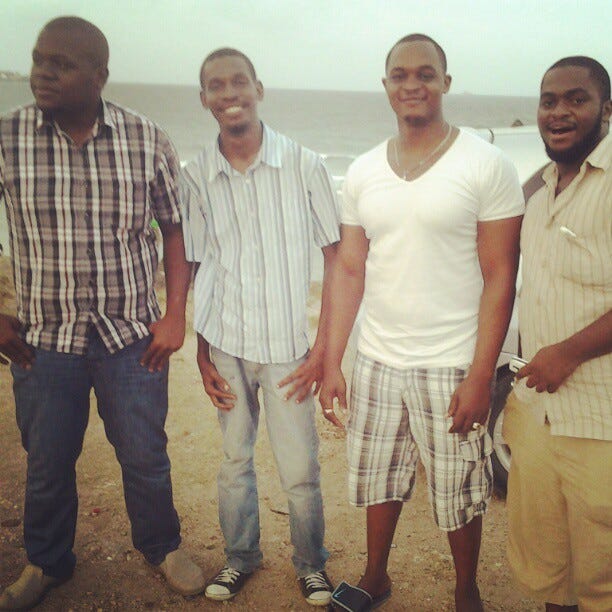Growing Up in Kariakoo, Biryan Ya Saigon, Miika Mwamba, Mwiba F.C and BRT Bus Stand.
The Home We Lost and The Tales of Where I Was Forged.
In the captivating narrative of my life, Karikoo appears as a recurring motif, mentioned seventeen times within the pages of "The Diary of an African Hub Manager." This locale, almost a character, profoundly influenced who I am today—my formative years amidst the dynamic milieu of Kariakoo exposed me to a diverse tapestry of experiences, each contributing to the rich fabric of my life story.
During that period, Kariakoo offered young individuals an array of potential paths. One could aspire to become a Bongo Flavour artist, composing melodies like Dully Sykes and the New Jack Family powered by the talented Finnish Producer Miikka Mwamba. Alternatively, some chose to forego formal education, emulating the path of Mr. Blue and crafting a hit song that resonated with the masses. In those days, Ali Kiba was not yet the megastar we know today, but a promising footballer, left-footed and representing Mwiba F.C., a team of savvy entrepreneurs turning scrap metal into fortunes.
Yet, beyond these well-trodden routes, the true luminaries of Kariakoo were our brothers who ventured south, returning with illicit spoils such as stolen phones and cars or impressively forged official documents that fetched substantial sums.
“By the time we reached seventh grade, our young lives were already intertwined with Internet Cafes. We’d venture into nightclubs, even stepping into the iconic Club Billicanas before we reached high school. As we entered our first year of secondary school, we became part of the ‘Terminator’ crew and felt like we knew every nocturnal secret that Dar es Salaam held. ‘Ladies Free’ Fridays and HK were staples of our late-night discussions, adding a vibrant thread to the tapestry of our adolescent experiences, we owned the city”

Affectionately referred to as "Wasanii," or artists, they were masters of the craft, capable of replicating even the most intricate government papers. Whether one sought a marriage certificate, a coveted college diploma, or insurance papers, these artisans possessed the skills to fulfil those clandestine desires. They mainly resided in Mkunguni, where the barter trade of stolen phones was happening. You had a 70 per cent chance of getting a phone stolen that day if you visited that place, and they didn't have a problem selling it back to you if you asked politely.
Amid this diversity, a group of enigmatic figures known as the "Wazungu Wa Unga," dealing in the shadowy realms of narcotics, also thrived. Their presence added an enigmatic layer to the tapestry of Kariakoo. Unfortunately, we lost many friends and families who broke the first rule of "Wazungu Wa Unga", "Don't get high from your own supply". Most fell into the trap of drug abuse, some went to jail for being "pushers", and some succumbed to the aftermath of long-term usage and overdose.
Curiously, I could have ventured down these intriguing paths. Yet, destiny had different plans for me. My voice lacked the melodic enchantment of a singer, and my feet were far from the finesse of a gifted footballer. Yet, within this eclectic panorama of possibilities, I embarked on a journey uniquely mine.
A Bit of History
Kariakoo, a time-worn heart in the embrace of Africa's urban tapestry, is one of the continent's most ancient city centres. Its name, a melodic echo of history's whispers, finds its roots in the distorted echoes of the Carrier Corps — a labour force born amidst the turbulent currents of World War I. This corps was forged to supply the military might necessary to bolster the British campaign against the German troops in the vast expanse of East Africa.


In the annals 1916, the British conquest of Dar es Salaam unfolded. Within the intricate web of this historic chapter, Kariakoo emerged as the sturdy fulcrum upon which the Carrier Corps pivoted—a place where lives and destinies intermingled with the march of history.
Yet, it is not solely through the lens of conflict that Kariakoo finds its place in the story of ages. This storied enclave is celebrated far and wide for its iconic market — a living testament to the passage of time. Nestled in its bustling embrace, a market that has withstood the test of time, a living tapestry of trade and culture, breathing with the vitality of generations. A market conceived by German hands in the early 1920s, an astonishing 38 years before the dawn of Tanganyika's independence. Amazingly, the market still stands today.
Biryan Ya Saigon
These were rich Africans of the pre-independence era. Growing up, I attended various religious ceremonies commemorating the great people of Kariakoo: sheikhs, business people, politicians, etc., hosted at Saigon Club, one of the oldest social clubs in Dar es Salaam. The club is a community with one of the richest histories in Dar es Salaam. It is a cross-generation club with influence in the city and national politics. Hanging there will keep you in the loop about the "who is who" in the town and country.
Being raised in Kariakoo was a gem unto itself; I learnt a great deal about the ways of inner-city living. You naturally become certified as street savvy. Friends who grew up in remote parts of the country regularly criticize my work ethic. "No wonder you work so hard; the only thing you know is city life, and you probably can't even work a hand hoe," they would tease me. I would retort with an old Dar es Salaam quip that being born and raised in a big city like Dar es Salaam amounts to a college degree. To survive in Kariakoo, you need to have street smarts and be able to improvise.
Improvisation is everything you need to enjoy "Biryan Ya Saigon". Annually, thousands of Kariakoo dwellers will meet to pray and remember those who have passed away in a traditional Islamic ceremony, the Mawlid, also known as "Kisomo" in Swahili. This was an opportunity to eat the right amount of Biryan if you know and are connected to the right Sheikh. Rest in Peace, “Askofu”, Mzee Saliboko. We will never forget your commanding voice pushing for more silver plates to come in our direction. Still, it is one of the best Biryan I ever tested. It carries tonnes of my childhood memories.
Vinanda Vya Miika Mwamba — Musical Instruments of Miika Mwamba
It took me years to realize he wasn't called "Nigga Mwamba" and he wasn't black; instead, a Finnish white guy called Miikka Mwamba, real name, Miikka Aleksanteri Kari. I don't know how he ended in Tanzania or how he did what he did but I know for a fact if there is a "Hall of Fame" for Bongo Flavour. I still enjoy "Salome" up to today.
Dully Skyes built a foundation for Mr. Blue, Abby Skills, and Ali Kiba. I was more optimistic with Abby than Ali, but Ali's success will surpass the rest over time. I still remember the small studio at Kipata Street where most of these guys used to hang out and sharpen their skills. I need to find out where Queen Darleen is. Rest in peace, Tudo, and I pray for Chid Benz. One of these days, the golden generation of Kariakoo and Ilala will come together and do a massive concert for their old fans. I can't imagine listening to "Vinanda Vya Miikka" in a public concert. I won't be able to dance "Shikide" or "Malewa", but I will enjoy the tunes that come with priceless memories of where I grew up.
Mwiba F.C and The Tales of Kombe La Mbuzi
I still vividly recall the echoes of "Vigoma," the rhythmic chants resonating from Uruguay F.C. in Buguruni during our fervent prayers against Maiwa F.C. hailing from Mchikichini. Rest in Peace, Saidi Mwamba Kizota, whose memory remains in those passionate clashes. Few spectacles could rival the electric atmosphere when Buguruni's spirited youngsters faced off against the spirited souls of Mchikichini.
Street football, a canvas of raw talent, offered a stage for undiscovered gems from diverse corners. I remember witnessing the likes of Credo Mwaipopo, Suleiman Matola, the Mahadhi Brothers, Kijuso, and countless other gifted footballers, who would later ascend to national stardom, emerging from teams like Ashanti F.C., Shwangwe F.C., Wakigoma, and more.
Occasionally, sparks of conflict would ignite amidst the fervour as each street and locality sought to establish supremacy over the other. We were always braced for whatever might transpire, knowing that pride and honour were at stake in these fiercely contested matches.
Our Home Turning Into a Bus Stand
The traces of my childhood in Kariakoo have dwindled, fading like echoes over time. After years of battles against the central government and the city council, our cherished homes eventually succumbed to the relentless march of progress and transformed into bustling bus stands. It's a bittersweet truth that lingers in my heart — the realization that I never captured enough photographs of the place where I came of age.
For those newcomers to Dar es Salaam, attempting to convey the essence of what once existed where the city's central BRT bus stand now stands can be an uphill task. Indeed, our parents received compensation, but there are aspects of our past that are utterly priceless. How can one possibly put a price tag on the treasury of childhood memories?
I remain deeply connected to that place, its spirit coursing through my veins. I imbibed Everything I learned about life, faith, relationships, hard work, and culture from those vibrant streets. I yearn to have something tangible to share with my children, a tangible relic of the place that shaped me.
Yet, even without physical remnants, the memories endure, etched in the recesses of my mind, ready to be recounted and passed down through the generations. The lessons learned, the experiences lived, and the love forged in Kariakoo are a part of me that can never be taken away. In many ways, they remain the most authentic and most enduring treasures of all.
Kariakoo, with its eclectic cast of characters and captivating stories, remains a cherished backdrop against which the story of my life unfolded. It was where dreams took flight, choices held weight, and existence played out in vibrant, unexpected harmonies. Looking back now, I realize that the essence of Kariakoo has woven the tapestry of my life into something truly distinct, a story meant to be shared and savoured.
Dedicated to My Childhood Friends and homies we lost along the way.
Happy Holidays.
